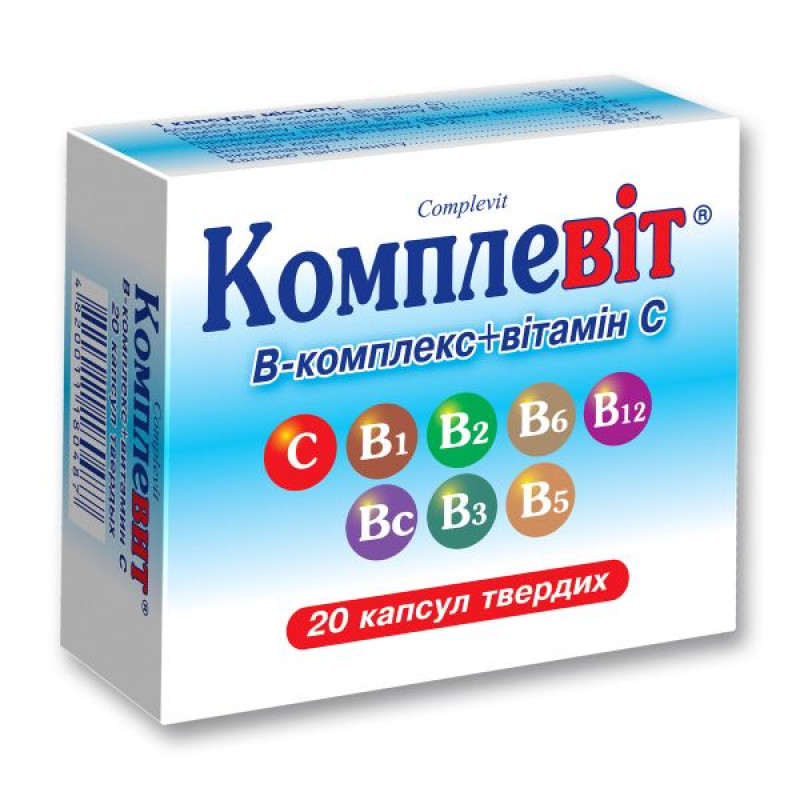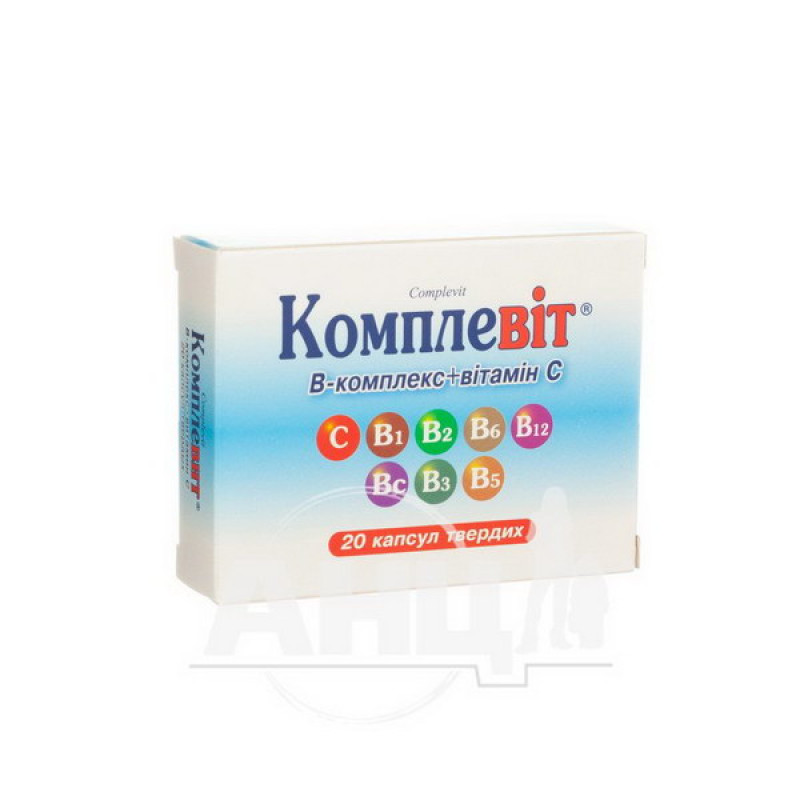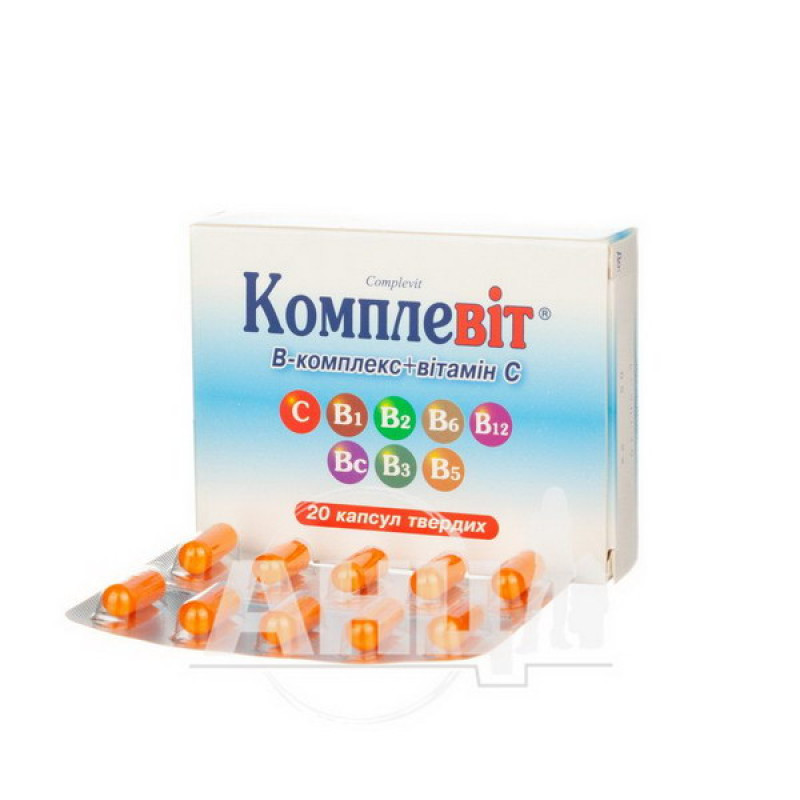Complevit hard capsules blister No. 20

Pharmacological properties
Pharmacodynamics. Complevit is a multivitamin preparation. The action of the preparation is determined by the properties of water-soluble vitamins of group B and vitamin C, which are part of it and are components of enzyme systems; actively affect various functions of the body: regulate energy and metabolic processes in the body, normalize the work of organs and systems, accelerate tissue regeneration processes, increase the body's performance during mental and physical stress, contribute to increasing the body's resistance to infectious diseases, adaptation to stress.
Vitamin B1 normalizes the functional activity of the nervous, cardiovascular and digestive systems.
Vitamin B2 plays an important role in protein, fat and carbohydrate metabolism, participates in maintaining normal visual acuity, and normalizes skin functions.
Vitamin B6 is necessary for the regeneration of skin and liver cells, restoration of the nervous system, and improves fat metabolism in atherosclerosis.
Folic acid, in addition to its anti-anemic effect during pregnancy, protects the fetus from the effects of teratogenic factors and participates in the metabolism and synthesis of amino and nucleic acids.
Vitamin PP is a specific anti-pellagra agent that improves carbohydrate metabolism.
Calcium pantothenate plays an important role in oxidation processes, participates in carbohydrate and fat metabolism, and in the synthesis of acetylcholine, which is involved in the transmission of nerve impulses.
Vitamin B12 affects the processes of normal maturation of all body cells, especially blood and liver cells, and has a beneficial effect on the functioning of the nervous system and liver.
Vitamin C plays an important role in regulating redox processes, carbohydrate metabolism, blood clotting, tissue regeneration, normal capillary permeability, the formation of steroid hormones and connective tissue components, and helps increase the body's resistance to infectious diseases.
Pharmacokinetics. The drug is well absorbed in the digestive tract, its metabolic products are excreted from the body mainly with feces and urine.
Indication
Treatment of hypo- and avitaminosis caused by insufficient intake or increased need for vitamins: irregular and monotonous nutrition; improvement of metabolism and general condition of all age groups; period of increased mental and physical exertion; period of pregnancy and breastfeeding; period of active sports; stress; chronic disease; period of recovery after serious illnesses, after antibiotic and chemotherapy, before and after surgical operations; in the complex treatment of patients with atherosclerosis, coronary heart disease and liver diseases.
Application
Complevit should be taken orally during meals, with plenty of water. Adults and adolescents over 14 years of age are prescribed 1-2 capsules once a day, the course of treatment is 20 days. If necessary, a second course is carried out after 2 months (after consulting a doctor).
Contraindication
Increased individual sensitivity to any components of the drug, thromboembolism, tendency to thrombosis, thrombophlebitis, erythremia, erythrocytosis, severe kidney disease, gastric and duodenal ulcers, severe liver dysfunction, active hepatitis, neoplasms (except in cases accompanied by megaloblastic anemia), ag (severe forms), gout, hyperuricemia, nephrolithiasis, disorders of iron and copper metabolism, hypercalcemia.
Side effects
On the part of the immune system: possible hypersensitivity reactions to the components of the drug, including anaphylactic shock, bronchospasm, angioedema.
Metabolism and digestion: hypercalcemia.
Cardiovascular system: arterial hypertension.
From the hematopoietic system: hemolysis of erythrocytes in patients with glucose-6-phosphate dehydrogenase deficiency, blood clotting disorders.
From the nervous system: headache, dizziness, sleep disturbances, increased excitability, fatigue.
On the part of the organ of vision: visual impairment, dry skin/mucous membrane of the eye.
Gastrointestinal tract: dyspepsia, nausea, vomiting, belching, stomach pain, constipation, diarrhea, increased secretion of gastric juice.
Skin and subcutaneous tissue disorders: rash, urticaria, itching, redness.
On the part of the kidneys and urinary tract: urine discoloration, hypercalciuria, crystalluria, glucosuria.
General disorders and administration site conditions: hyperthermia, irritability, hyperhidrosis, hot flashes, which may be accompanied by a feeling of palpitations.
The following side effects may occur during prolonged use of high doses.
Metabolism and digestion: hyperuricemia, impaired glucose tolerance, hyperglycemia, impaired zinc and copper metabolism.
Nervous system: paresthesia, convulsions, loss of appetite.
From the cardiovascular system: arrhythmias, arterial hypotension.
From the hematopoietic system: erythrocytopenia, neutrophilic leukocytosis.
Gastrointestinal tract: gastrointestinal disorders.
Skin and subcutaneous tissue disorders: hair loss, seborrhea, hyperpigmentation.
Renal and urinary disorders: renal failure.
From the hepatobiliary system: jaundice, fatty liver disease.
Musculoskeletal system: myalgia, myopathy.
Laboratory indicators: temporary increase in AST, LF, LDH levels, increased uric acid levels in the blood, electrolyte imbalance.
The drug contains lactose, so it should not be used in patients with hereditary galactose intolerance, lactase deficiency or glucose-galactose malabsorption syndrome. It is not recommended to use with other multivitamin complexes to avoid overdose and the development of adverse reactions.
The urine may turn yellow, which is a completely harmless factor and is explained by the presence of riboflavin in the preparation.
The drug should be taken with caution in patients with diabetes mellitus, dystrophic heart diseases, diseases of the blood-forming organs, disorders of iron metabolism (hemosiderosis, hemochromatosis, thalassemia), gastrointestinal diseases, glaucoma, hemorrhages, moderate hypotension. When using the drug, blood pressure and kidney function should be monitored. It should be noted that the use of ascorbic acid in high doses can change some laboratory parameters (blood glucose levels, transaminases, uric acid, creatinine). Simultaneous administration of ascorbic acid with alkaline drinks reduces its absorption, so the drug should not be washed down with alkaline mineral water. Do not take the drug with hot drinks (especially coffee), alcohol. It is not recommended to take the drug at the end of the day, since ascorbic acid has a mild stimulating effect. Do not exceed the recommended dose.
Use during pregnancy and breastfeeding. Take only as directed by a doctor. During pregnancy, the use of excessive doses of ascorbic acid can lead to the development of its deficiency and dependence in the fetus. Ascorbic acid passes into breast milk.
Children. The drug in this dosage form should not be used in children under 14 years of age.
Ability to influence the reaction speed when driving or operating other mechanisms. There are no indications that the drug may have a negative effect on driving or operating complex machinery.
Interactions
When using short-acting sulfonamides with ascorbic acid, the risk of crystalluria increases. When used simultaneously, it enhances the effect of penicillin, increases iron absorption, reduces the effectiveness of heparin and indirect anticoagulants, increases aluminum absorption (consider when treating with aluminum-containing antacids). Vitamin C absorption decreases when used simultaneously with oral contraceptives, fruit or vegetable juices, alkaline drinks. Ascorbic acid can be taken only 2 hours after deferoxamine injection. Long-term use of high doses of ascorbic acid reduces the effectiveness of disulfiram treatment. High doses of the drug reduce the effectiveness of tricyclic antidepressants, neuroleptics - phenothiazine derivatives, tubular reabsorption of amphetamine, and disrupt the excretion of mexiletine by the kidneys.
Ascorbic acid increases the total clearance of ethyl alcohol. Quinolone drugs, calcium chloride, salicylates, tetracycline, corticosteroids with prolonged use reduce the reserves of ascorbic acid in the body. Ascorbic acid increases the excretion of oxalates in the urine and increases the risk of crystalluria during treatment with salicylates. Folic acid reduces plasma concentrations of phenytoin. Simultaneous use with antithrombotic drugs leads to an increased risk of bleeding, with hypotensive drugs - increased hypotension, with hypolipidemic drugs - increased risk of their toxic effects, with antidiabetic drugs - reduced hypoglycemic effect of the latter, with methyldopa or β-adrenoceptor blockers - a significant decrease in blood pressure, with probenecid - reduced effect of probenecid.
Vitamin B6 weakens the effect of levodopa, prevents the occurrence or reduces the toxic manifestations of isoniazid and other anti-tuberculosis drugs.
Ethyl alcohol, PAS, cimetidine, calcium preparations reduce the absorption of vitamin B 12. It is prescribed with caution to patients with angina pectoris, unstable angina and acute myocardial infarction, who are receiving nitrates, calcium channel antagonists and β-adrenoceptor blockers. Cases of rhabdomyolysis have been reported when using nicotinic acid with lovastatin.
Thiamine hydrochloride, by affecting the polarization processes in the area of neuromuscular synapses, can weaken the curare-like effect of muscle relaxants.
Riboflavin is incompatible with streptomycin and reduces the effectiveness of antibacterial drugs (oxytetracycline, doxycycline, erythromycin, tetracycline and lincomycin). Tricyclic antidepressants, imipramine and amitriptyline inhibit riboflavin metabolism, especially in heart tissues.
Overdose
In case of an overdose of the drug, dyspeptic symptoms (nausea, vomiting, diarrhea, epigastric pain), allergic reactions (itching, skin rashes), changes in the skin and hair, liver dysfunction, headache, drowsiness, lethargy, facial flushing, irritability may occur. In such cases, the drug is discontinued. Therapy is symptomatic.
Storage conditions
In the original packaging at a temperature not exceeding 25 °C.
There are no reviews for this product.
There are no reviews for this product, be the first to leave your review.
No questions about this product, be the first and ask your question.















